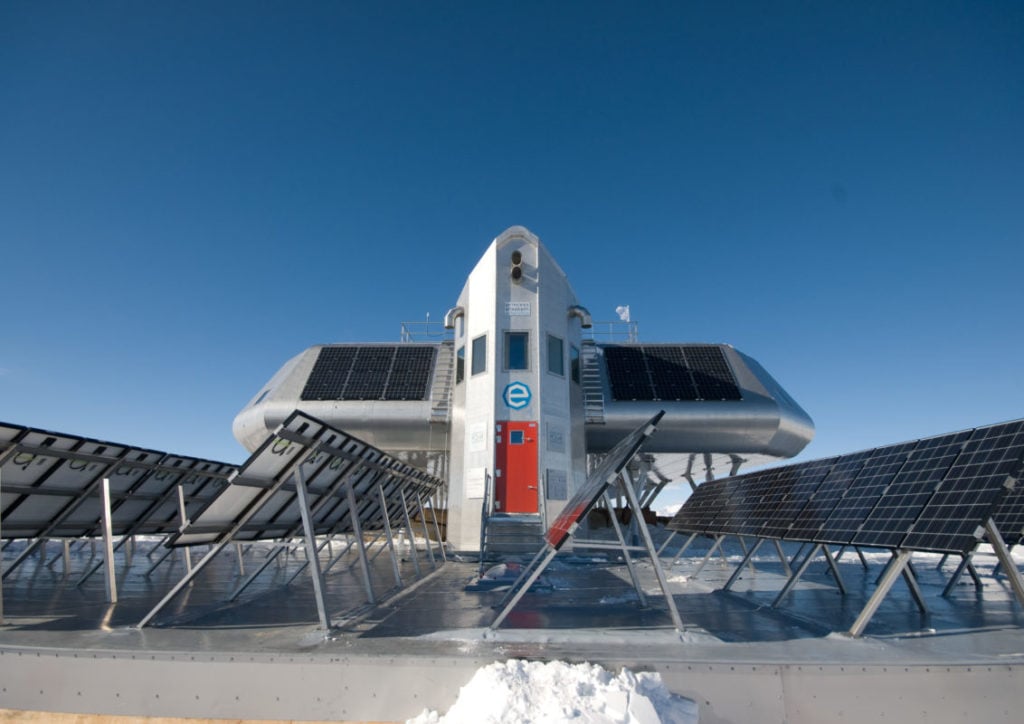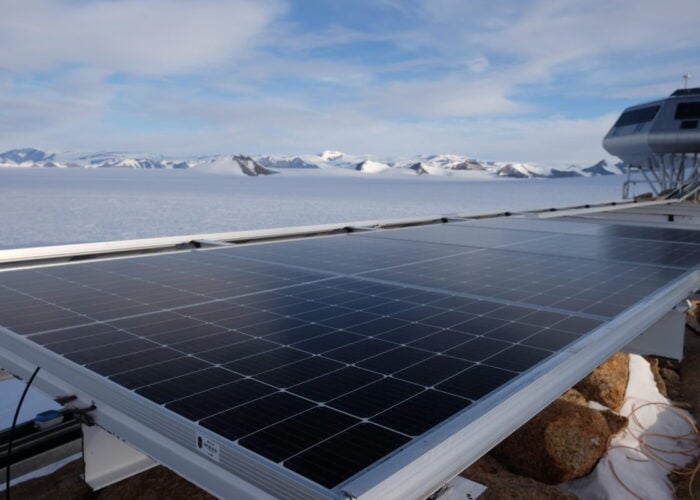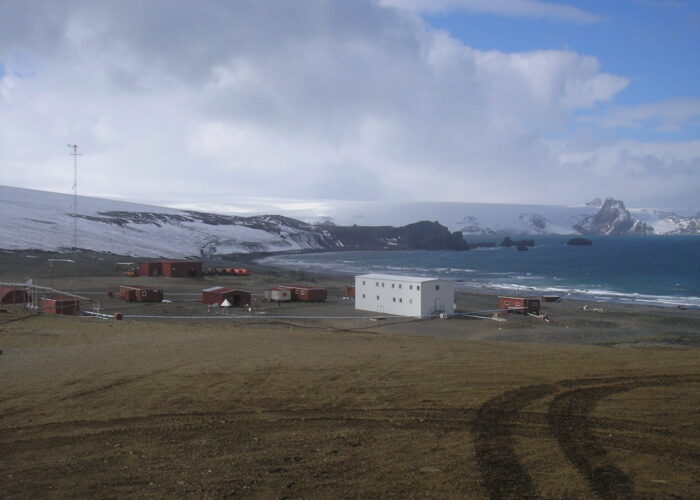
Antarctica is one of the harshest and most inhospitable environments for human activities due to its extreme climate. Traditionally, research stations in Antarctica were powered by fossil fuels. Powering a research station should not be an arduous task as it mainly requires a stable supply of electricity and heat. However, this simple requirement could be way more challenging in Antarctica. Currently, there are some exceptions such as the Princess Elisabeth Antarctica Research Station. Therefore, Simon Yuen talks to Slovenian solar company Bisol and the International Polar Foundation about features of renewable energy production at the Princess Elisabeth Antarctica Research Station.
Potential of solar power in Antarctica
Unlock unlimited access for 12 whole months of distinctive global analysis
Photovoltaics International is now included.
- Regular insight and analysis of the industry’s biggest developments
- In-depth interviews with the industry’s leading figures
- Unlimited digital access to the PV Tech Power journal catalogue
- Unlimited digital access to the Photovoltaics International journal catalogue
- Access to more than 1,000 technical papers
- Discounts on Solar Media’s portfolio of events, in-person and virtual
Solar power plants were limited to climates with an abundance of irradiance in the past, but it is getting more competitive at higher latitudes thanks to advanced technology and decreased production costs.
Characteristics of high latitude climates can affect the performance of solar power plants, according to the study Polar solar power plants – Investigating the potential and the design challenges co-conducted by Iver Frimannslund and Thomas Thiis from the Norwegian University of Life Science; Arne Aalberg from the University Centre in Svalbard, and Bjørn Thorud from consulting engineers and designers Multiconsult ASA.
For example, a decrease in cell temperature increases the solar cell voltage and slightly decreases the current, but the net outcome is an increased power output of about 0.35 to 0.5%/K. Moreover, the reflected irradiance caused by the high reflectivity of snow can enhance the irradiance collected by a solar module. As a result, bifacial solar modules can produce power from the irradiance received on both sides of the modules, and can greatly increase the power output in high-reflectivity climates.
In other words, reduced solar irradiation in the polar regions, compared to areas with lower latitudes, is compensated by increased efficiency resulting from low temperatures and high reflectivity, according to the study.
Apart from efficiency, settlements relying on fossil fuels as the main energy supply need to pay higher fuel costs due to the transportation of the fuel because of remoteness. Research stations in Antarctica also rely on fossil fuels which causes two problems. First, fuel is commonly shipped by boats from settlements or ports in other continents; second, fuel is transferred to inland stations by overland vehicles.
Considering the limitations of using fossil fuels, solar PV’s competitiveness, such as on-site power production, outweighs the high fuel costs of the existing solutions.
Despite the fact that there is potential for solar PV in polar regions, the extreme climate is one of the major problems in building solar power plants. The study highlights that the implementation of solar power systems must confront the climate effects caused by snow. Snow can shade the surface of modules, resulting in a lower power generation efficiency. Moreover, the development of snowdrifts in a solar power plant can also impose a mechanical load on the PV arrays.
How can the Princess Elisabeth Antarctica Research Station tackle the problems and thrive in Antarctica?
Antarctica has been the home of scientific research for decades, with multiple research stations operated by different countries on the continent. Located on Queen Maud Land, a region of Antarctica claimed by Norway as a dependent territory, the Princess Elisabeth Antarctica Research Station was designed as a prototype that can continually be improved over time, according to the International Polar Foundation, administrator of the research station.
The research station can access two of the most omnipresent features of the Antarctic weather: the wind and the sun. They are renewable sources that provide energy to the research station which claims to be zero-emissions.
According to the International Polar Foundation, the Princess Elisabeth Antarctica Research Station has 284 solar PV panels that produce an average of 420kWh per day. In addition, to better leverage solar irradiance, the station has 96 bi-facial modules that can be benefitted from snow reflected irradiance.
In addition to solar panels, nine wind turbines that can produce 6kW each are installed in the research station. Both solar modules and wind turbines supply 76% of the energy required by the station. The energy produced by these two sources are stored by 192 lead-acid batteries.
A total of 30 solar thermal panels are included in the station, providing 21% of the energy with the remaining 3% of energy being provided by a generator set.
Intelligent systems
As renewable energy production is variable, hence an intelligent system is installed to balance available energy and energy demand through a system of dynamic prioritisation. Generated energy will be transferred to a battery storage system with a total capacity of 438kWh before being transferred to a programmable logic controller.
The station consumes between 10-20kW on-season, so storage lasts for 13 to 26 hours if there is no sun or wind. The demand for energy can be divided into five categories, including safety, scientific research, daily usage from stationed researchers and staff, leisure and operations consisting of water treatment and distribution, snow melter, ventilation and heating.
Additionally, there are mobile solar-powered energy field units producing up to 25kWh per day so that scientists can use them while on extended research missions in the field.
The Princess Elisabeth Antarctica Research Station has a smart microgrid designed by research centre and technical service provider Laborelec, and an automated energy management system designed by Schneider Electric.
David Orgaz, CEO of Schneider Electric Belgium and the Netherlands, said that ensuring smart energy management is crucial to the polar station, adding that energy produced by solar modules and windmills is either stored in batteries or used immediately. Therefore, maintaining a balance between what is produced and what is consumed is critical, thereby minimising the station’s energy usage and eliminating energy waste.
Bisol’s role in the station
Recently, Slovenian solar company Bisol has installed more solar modules to power the research station in Antarctica.
Bisol says its 22kW project aims to meet the increasing energy needs of the Princess Elisabeth Antarctica Research Station. In February, the containers with the company’s solar modules arrived in Antarctica. Currently, 48 out of the 60 modules have been installed, with the remaining 12 modules being installed in the near future.
“Adding the new Bisol PV panels is not just about having more energy available. The panels are facing east because we want to harvest the morning sun,” says Guus Luppens, renewable energy system engineer of the International Polar Foundation.
The research station used to have a production gap between midnight and morning, but this is now covered by the new Bisol modules PV modules after the installations.
In the Polar solar power plants – Investigating the potential and the design challenges study, the authors highlight that the redistribution of snow is “caused by snow eroding from exposed areas and accumulating in sheltered areas, creating snowdrifts”. To reduce snowdrifts in unwanted areas, the design of infrastructure in polar regions needs to control where snow is deposited and eroded.
To ensure the resilience of solar power plants in snowdrift climates, the design should be adapted to snowdrift development. This can be performed by adapting the configuration of the PV arrays so that snow is deposited in designated areas or so that the deposition is minimised.
Luppens says due to the strong katabatic wind — a wind carrying high-density air from a higher elevation down a slope under the force of gravity — and the acceleration of the wind on the ridge, almost no snow is accumulating on this PV array.
But some special designs are adopted in such an extreme environment. “We learned to never underestimate the power of the katabatic winds in Antarctica. The mounting system has been carefully designed to withstand the high winds,” says Luppens, adding that the PV modules did not receive any adjustments as they are -40°C-rated.
For wind turbines, they are designed for harsh conditions, according to Luppens. The blades tilt when the wind speed is too high, causing them to catch less wind and preventing the blades from overspeeding. The company also installs a dumpload system to ensure enough braking power by consuming all produced energy.
Operations and maintenance
The operations and maintenance of the solar modules could be a problem due to the extreme weather. To prevent the solar modules and wind turbines from being damaged by any external factors, the systems are designed to be firmly fixed so that they could avoid vibrations. However, Luppens admits that the solar power systems and wind turbines are more prone to damage or unstable due to extreme weather.
For the wind turbines, Luppens says they need yearly maintenance. He also claims that as PV modules boast no moving parts, so they do not need any maintenance.
Speaking of the design of the systems, there were some difficulties during the construction process. According to Luppens, the ridge on which the Princess Elisabeth Antarctica Research Station is built in a very windy place. What makes the installation process more difficult is that the winds accelerate in the area close to the station. To successfully install the systems and modules, the process needs to be done on days with low wind speed with extra caution since the surrounding area can be very slippery because of the icy surface.
The research station is designed to operate without any humans on site, while it also can remain unmanned for up to eight months. By using programmable logic controllers and supervisory control and data acquisition systems, the operators can monitor and control light, switches, valves, and thermostats from a remote place.
“Excluding all possible failures is, of course, not possible, but we do try to make sure all scientific instruments stay operational during the whole winter until the first crew member arrives again,” Luppens tells.
What makes Bisol start working on this project in Antarctica?
The Princess Elisabeth Antarctica Research Station was established in 2009. Bisol established the first contact with Brussels-based International Polar Foundation in January 2022 to plan the project.
“The project demonstrates how the climate challenge can be met and how readily accessible technology can help us achieve a low-carbon society,” says the company in a statement.
It adds that the design and clean energy concept of the research station integrates passive building technologies, renewable wind and solar installations, together with power electronics in a micro smart grid that delivers maximum energy efficiency.
The quality, reliability and low degradation of solar modules are areas that are particularly important in severe weather conditions in Antarctica. Bisol says it only uses top quality EVA foil and longer lamination. Additionally, the company invests in its own climate chamber, performs peel tests on every module and also develops tailor-made BISOL tracking systems.
Asked by PV Tech Power about the reasons for working on this project, the spokesperson of Bisol says that the project’s zero-emissions goal aligns with the company’s values and missions, which involve energy solutions that are being commercialised in mainstream applications. Second, Bisol hopes to use this project, located at an unusual location, as an opportunity to showcase its products as the company’s presence spans more than 100 countries at the moment.
“We believe that companies can play a key role in building a sustainable economy and society, which is why we take our responsibility towards the environment and the community around us very seriously,” the company says.
Bisol started manufacturing solar PV modules in 2004, and expanded its business to PV mounting solutions and investments in solar power plants in 2009. Currently, with an annual capacity of 750MW, the company says its products are sold to more than 100 countries.
How to build a sustainable solar power plant in polar regions?
In the Polar solar power plants – Investigating the potential and the design challenges study, the authors detail how to build a sustainable solar power plant in polar regions.
The authors use a solar power plant in Adventdalen, Svalbard in Norway as an example. The climate in the area is characterised by significant horizontal redistribution of snow due to little shelter and strong winds, causing snowdrifts to develop in the aerodynamic shade of the PV arrays.
The study also indicates that PV array snowdrifts exhibit a similarity with snow fence snowdrifts, so the snow fence theory can be used to minimise the accumulation from the PV arrays. Snow fences can cause turbulence in the wind so that it drops much of its snow load on the lee side of the fences.
By using the snow fence theory, developers can consider the adjustment of azimuth, array tile and bottom gap of PV arrays to minimise snow accumulation in the plant.
A strong inclination for snow fences can reduce the net height of the fence and the subsequent snow storage capacity. Therefore, inclining the PV arrays significantly while maintaining a bottom gap is likely to reduce the storage capacity of the PV produced snow drifts.
Another key area developers need to take note of is that the plant should be resilient against snowdrifts, which are a direct consequence of the aerodynamic shade from objects and terrain. The authors suggest that a modification of the design of the solar power plant can be used to control snow accumulation and erosion in the plant.




